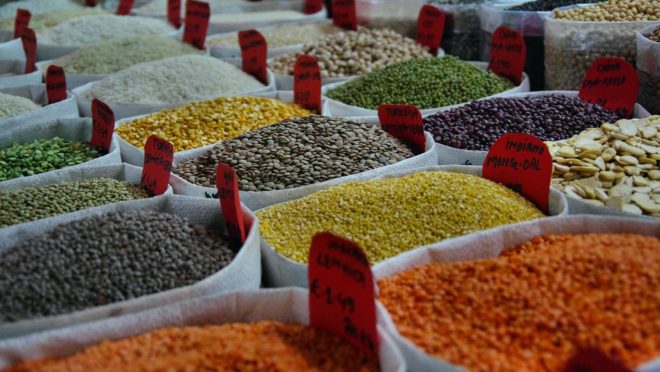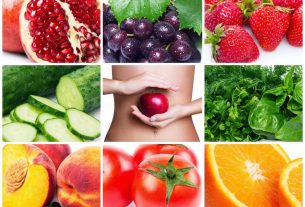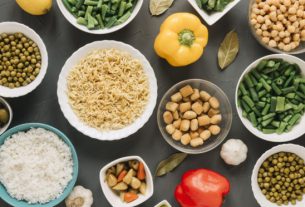In addition to all the nutritional benefits, grains have immense importance in human history. Because, the domestication and cultivation of grains was essential for the Neolithic Revolution, around 10,000 BC. Agriculture contributed to us moving from being hunter-gatherers to settling in specific regions, creating communities and cities and expanding human populations.
Although many people find them caloric, these foods are the base of the food pyramid, and are still essential for our daily lives today. With that in mind, in this content we have brought some information about these cereals that are so relevant to human history, but now, from a nutritional point of view and their individual impact on the body.
So, get ready to learn about the differences between whole and refined grains, the benefits of including grains in your diet and check out a list of the most popular grains with suggestions on how to combine them. Follow the content!
Understand the differences between whole and refined grains
Before explaining the difference between whole and refined grains, it is worth understanding what they have in common. Grains, also known as cereals, are seeds that are in ears. These grains are structured as follows:
- Bran: The bran is the outermost layer of the grain. It is rich in fiber, B vitamins and minerals. This part is often removed during grain processing to produce white flour, resulting in a significant loss of nutrients.
- Germ: The germ is the inner layer of the grain, often considered the “embryo”. It is the part that contains essential nutrients for plant growth, such as vitamins, minerals and healthy fats. It is a very nutritious part of the grain.
- Endosperm: The endosperm is the middle layer of the grain and occupies most of its volume, around 80% to 85%. It is rich in starch, which is the plant’s main source of energy. Additionally, most grains also contain certain amounts of protein in the endosperm.
See below an image that exemplifies the issue:
Now that you know what a grain is, let’s understand the differences between them:
| Característica | Whole Grains | Refined Grains |
| Definition | Present in whole form or ground into flour, keeping all parts of the seed (bran, germ and endosperm) | They go through a refinement process to remove the germ and bran. |
| Nutrients | Fibers. B complex vitamins, Iron, Folate, Selenium, Potassium, Magnesium. | It loses a good part of the nutrients, but extends the shelf life of the grains and their flours. |
| Nutritional Loss | Maintain most essential nutrients. | They lose many nutrients, including fiber. |
| Benefits | Higher fiber content, promoting digestive health. Essential nutrients contribute to overall health. | Soft texture and mild flavor. Longer product lifespan. |
| Examples | Brown rice, oats, quinoa. | White rice, white wheat flour. |
In summary, the main difference between refined and whole grains comes from the refinement process which removes the outer layers of the grain, which impacts the quantity and quality of nutrients. Whole grains therefore have a greater quantity and quality in nutritional terms.
But an important point to note is that refined grains still contain calories, carbohydrates, proteins and reduced amounts of vitamins and minerals, such as some B vitamins and iron.
What are the healthiest grains?
As shown in the table above, whole grains maintain a greater amount of nutrients in their composition. However, this does not mean that only whole grains are healthy. Both refined and whole grains are healthy.
We should not think of foods as isolated, but yes, combined. It is not necessary to eat only whole grains, but it is important to vary your plate with other foods that contain vitamins, minerals and fiber.
Benefits of including healthy grains in your diet
The grains are in base of the food pyramid, such importance in our diet. These foods are rich in complex carbohydrates and provide energy for our body. Furthermore, these foods are rich in vitamin B and ironand many other phytonutrients considered essential to health.
Additionally, grains are rich in fiber. The group of legumes that includes chickpeas, carioca beans, peas and lentils contribute to better bowel function, making the evacuation process easier and more comfortable.
Furthermore, foods in this group are rich in tryptophan, an essential amino acid for the production of serotonin, neurotransmitter that helps us feel good and relaxed. In addition to improving our intestinal functioning, grains contribute to our emotional well-being.
See also | Does rice have gluten? Check out which grains to add or remove from your diet
Healthy Grains: list of the most popular
As we said above, we cannot think about food in isolation. Therefore, below, we have put together a list of the most popular grains and brought some combination suggestions for greater nutritional gain.
Remember: these lists are just consumption suggestions, the ideal is to always look for a health professional who can advise which diet is best suited to your routine.
Quinoa:
- Why it’s healthy: Rich in protein, fiber, iron, magnesium and B vitamins, quinoa is a highly nutritious grain.
- How to combine it: Use quinoa as a substitute for rice in dishes such as salads, pilaf and even for breakfast in the form of porridge.
Oat:
- Why it’s healthy: Contains soluble fiber that helps reduce cholesterol and stabilize blood sugar.
- How to combine it: Make oatmeal for breakfast with fruit and nuts, or use it to make healthy cookies and pancakes.
Bean:
- Why it’s healthy: Excellent source of vegetable proteins, fiber, iron and folate.
- How to match it: Make bean chili, add it to salads, or simply enjoy a bowl of beans and rice.
Lentils:
- Why they are healthy: They are rich in fiber, proteins, iron and folate.
- How to combine them: Make lentil soup, add them to curries, or use them to make veggie burgers.
Chickpea:
- Why it’s healthy: A source of protein, fiber, iron and folate, chickpeas are great for digestive health.
- How to match it: Make hummus, add chickpeas to salads, or prepare a chickpea curry dish.
Integral rice:
- Why it’s healthy: Contains fiber and essential nutrients that white rice loses during refining.
- How to match it: Use it as a base for dishes like sushi, rice bowls, or as a side dish for grilled vegetables.
Millet:
- Why it’s healthy: It is an excellent source of fiber, protein, magnesium and antioxidants.
- How to match it: Cook it as a substitute for rice or mix it into salads.
Almonds (Yes, they are a nut, but they are healthy!):
- Why they are healthy: Rich in healthy fats, proteins, fiber and vitamin E.
- How to combine them: Add chopped almonds to yogurt, salads or eat them as a snack.
Chia:
- Why it’s healthy: Contains fiber, omega-3 fatty acids and proteins.
- How to combine it: Blend chia seeds into yogurt, oatmeal or smoothies to boost nutritional value.
Linseed:
- Why it’s healthy: Source of fiber, omega-3 fatty acids and lignans, which have antioxidant properties.
- How to combine it: Grind flaxseeds and sprinkle on cereal, yogurt or use as an egg substitute in vegan recipes.
Now that you know the benefits of grains for our diet and know how to combine them, the question may arise as to where to find quality grains. Normally, natural product stores have a catalog with several items from trusted brands that have quality control throughout the manufacturing process.
As is the case with the distributor Tainá Alimentos, a reference in the natural products market that is committed to creating gluten-free products. With more than 30 varieties of grains ranging from Oats, Chica, Beans, Corn to Quinoa and Pumpkin Seeds, Tainá Alimentos is an example of a trusted brand that can be found in stores specializing in natural foods.
How about taking grain intake seriously in your diet by eating quality grains? With these healthy choices, you can enjoy a nutrient-dense diet, contribute to your long-term health, and experience a variety of flavors and textures that make every meal a healthier experience. And yet, by consuming them, we keep this remarkable and important story of grains alive: both for humanity and on an individual level.
References
BRAZIL. Ministry of Health. Department of Health Care. Department of Primary Care. Food guide for the Brazilian population. 2nd ed., Brasília: Ministry of Health, 2014.

Sign up for our newsletter and stay up to date with exclusive news
that can transform your routine!
Warning: Undefined array key "title" in /home/storelat/public_html/wp-content/plugins/link-whisper-premium/templates/frontend/related-posts.php on line 12
Warning: Undefined array key "title_tag" in /home/storelat/public_html/wp-content/plugins/link-whisper-premium/templates/frontend/related-posts.php on line 13




